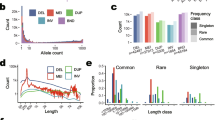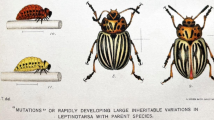Abstract
Trans-dominant linked markers pairs (trans referring to the repulsion linkage phase) provide a model for inferring the F2 progeny genotype based upon both the conditional probabilities of F2 genotypes, given the F2 phenotype, and prior information on marker arrangement. Prior information of marker arrangement can be readily obtained from a linkage analysis performed on marker segregation data in a family resulting by crossing the F1 individual to a “tester” parent or else can be obtained directly from the gametes of the F1, or from recombinant inbred lines. We showed that a trans-dominant linked marker (TDLM) pair can be recoded as a “co-dominant megalocus” when the recombination fraction, r1, for apair of TDLMs is less than 0.05. We obtained a maximum-likelihood estimator (MLE) of the recombination frequency, r2, between a TDLM pair and a co-dominant marker in an F2 family using the EM algorithm. The MLE was biased. Mean bias increased as r1 and r2 increased, and decreased as sample size increased. The information content for r2 was compared to the information content of dominant and co-dominant markers segregating in an F2 family. It was almost identical with two co-dominant markers when r1≤0.01 and r2≥0.05. For larger values of r1, (0.05≤r1≤0.15) a TDLM pair provided 75%–66% of the information content of two co-dominant markers. Although dominant markers can be converted to co-dominant markers by a laborious process of cloning, sequencing, and PCR, TDLM pairs could easily substitute for co-dominant markers in order to detect quantitative trait loci (QTLs) and estimate gene action in an F2 family.
Similar content being viewed by others
References
Al-Janabi SM, Honeycutt RJ, McClelland M, Sobral BWS (1993) A genetic linkage map of Saccharum spontaneum L. ‘SES 208’. Genetics 134:1249–1260
Allard R (1956) Formulas and tables to facilitate the calculation of recombination values in heredity. Hilgardia 24:235–278
Becker J, Vos P, Kuiper M, Salamini F, Heun M (1995) Combined mapping of AFLP and RFLP markers in barley. Mol Gen Genet 249:65–73
Caetano-Anolles G, Bassam BJ, Gresshoff PM (1991) A high-resolution DNA amplification fingerprinting using very short arbitrary oligonucleotide primers. Biotechnology 9:553–557
Chang C, Bowman AW, Lander ES, Meyerowitz EW (1988) Restriction fragment length polymorphism linkage map of Arabidopsis thaliana. Proc Natl Acad Sci USA 85:9856–6860
Chaparro JX, Werner DJ, O'Malley D, Sederoff RR (1994) Targeted mapping and linkage analysis of morphological, isozyme and RAPD markers in peach. Theor Appl Genet 87:805–815
Darvasi A, Weinreb A, Minke V, Weller JI, Soller M (1993) Detecting marker-QTL linkage and estimating QTL gene effect and map location using a saturated genetic map. Genetics 134:943- 951
Dempster AP, Laird NM, Rubin DB (1977) Maximum likelihood from incomplete data via the EM algorithm. J R Statist Soc Series B 39:1–39
Eck HJ van, van der Voort JR, Draaistra J, van Zandvoort P, van Enckevort E, Segers B, Peleman J, Jacobsen E, Helder J, Bakkler J (1995) The inheritance and chromosomal localization of AFLP markers in a non-inbred potato offspring. Mol Breed 1:397–410
Edwards MD, Stuber CW, Wendel JF (1987) Molecular-marker-facilited investigations of quantitative trait loci in maize. I Numbers, genomic distribution and type of gene action. Genetics 116:113–125
Grattapaglia D, Sederoff R (1994) Genetic linkage maps of Eucalyptus grandis and E. urophylla using a pseudo-testcross mapping strategy and RAPD markers. Genetics 137:1121–1137
Knapp SJ, Holloway JL, Bridges WC, Liu BH (1995) Mapping dominant markers using F2 matings. Theor Appl Genet 91:74–81
Nam HG, Giraudat J, den Boer B, Moonan F, Loos WDB, Hauge BM, Goodman HM (1989) Restriction fragment length polymorphism linkage map of Arabidopsis thaliana. Plant Cell 1:699–705
Paran I, Michelmore RW (1993) Development of reliable PCR-based markers linked to downy mildew resistance genes in lettuce. Theor Appl Genet 85:985–993
Paterson AH, Damon S, Hewitt JD, Zamir D, Rabinowitch HD, Lincoln SE, Lander ES, Tanksley SD (1991a) Mendelian factors underlying quantitative traits in tomato: comparison across species, generations and environments. Genetics 127:181–197
Paterson AH, Tanksley SD, Sorrells ME (1991b) DNA markers in plant improvement. Adv Agron 46:39–90
Plomion C, Bahrman N, Durel C-E, O'Malley DM (1995) Genomic mapping in Pinus pinaster (maritime pine) using RAPD and protein markers. Heredity 74:661–668
Reiter RS, Williams J, Feldman K, Rafalski JA, Tingey SV, Scolnik PA (1992) Global and local genome mapping in Arabidopsis thaliana recombinant inbred lines and random amplified polymorphic DNAs. Proc Natl Acad Sci USA 89:1477–1481
Tanksley SD, Ganal MW, Prince JP, de Vicente MC, Bonierbale MW, Broun P, Fulton TM, Giovannoni JJ, Grandillo S, Martin GB, Messeguer R, Miller JC, Miller L, Paterson AH, Pineda O, Roder MS, Wing RA, Wu W, Young ND (1992) High-density molecular linkage maps of the tomato and potato genomes. Genetics 132:1141–1160
Vallejos CE, Sakiyama NS, Chase CD (1992) A molecular markerbased linkage map of Phaseolus vulgaris L. Genetics 131:733–740
Vos P, Hogers R, Bleeker M, Reijans M, van der Lee T, Homes M, Frijters A, Pot J, Peleman J, Kuiper M, Zabeau M (1995) AFLP: a new technique for DNA fingerprinting. Nucleic Acids Res 23:4407–4414
Welsh J, McClelland M (1990) Fingerprinting genomes using PCR with arbitrary primers. Nucleic Acids Res 18:7213–7218
Williams JGK, Kubelik AR, Livak KJ, Rafalski JA (1990) DNA polymorphisms amplified by arbitrary primers are useful as genetic markers. Nucleic Acids Res 18:6531–6535
Williams JGK, Hanafey MK, Rafalski JA, Tingey SV (1993) Genetic analysis using random amplified polymorphic DNA markers. Methods Enzymol 218:704–740
Author information
Authors and Affiliations
Additional information
Communicated by G. E. Hart
Rights and permissions
About this article
Cite this article
Plomion, C., Liu, B.H. & O'Malley, D.M. Genetic analysis using trans-dominant linked markers in an F2 family. Theoret. Appl. Genetics 93, 1083–1089 (1996). https://doi.org/10.1007/BF00230129
Received:
Accepted:
Issue Date:
DOI: https://doi.org/10.1007/BF00230129




